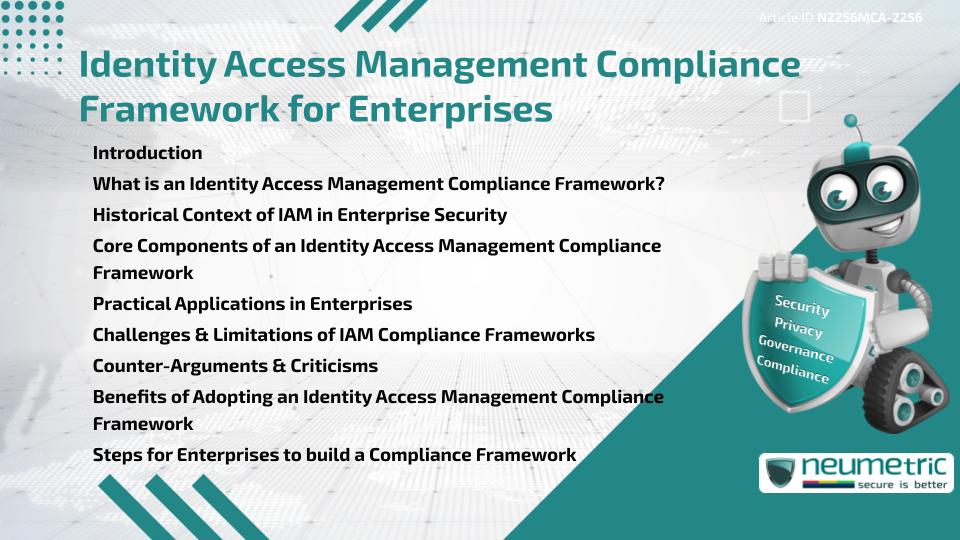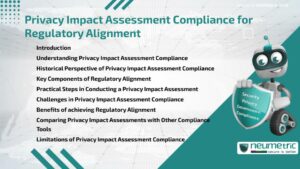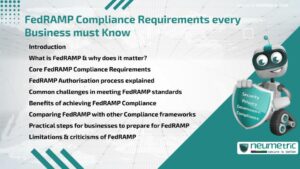Table of Contents
ToggleIntroduction
An identity access management compliance Framework is a structured system that enterprises use to regulate, secure & monitor access to digital resources. It ensures that only authorized individuals can access Sensitive Data & systems while aligning with Industry Regulations & legal obligations. This Framework reduces Risks of insider Threats, data breaches & non-compliance penalties. By combining technical controls, oversight Policies & Governance practices, enterprises build a strong foundation for digital trust & accountability.
What is an Identity Access Management Compliance Framework?
An identity access management compliance Framework provides enterprises with standardised rules & processes for handling User access. It governs how digital identities are created, maintained & deactivated, while ensuring compliance with regulations such as GDPR, HIPAA or SOX. The Framework is not only about security; it also supports operational efficiency by automating identity lifecycle management. Without such a Framework, enterprises face increased exposure to unauthorized access, system abuse & regulatory fines.
Historical Context of IAM in Enterprise Security
Identity & access management emerged in the early 2000s as businesses began shifting to digital environments. Initially, IAM solutions were designed to simplify User login processes. Over time, as Data Privacy regulations strengthened & cyberattacks grew more sophisticated, IAM expanded into compliance-driven frameworks. Today, enterprises are expected to align IAM practices with both security standards & regulatory requirements. Global Organisations such as NIST & ISACA have played significant roles in shaping IAM compliance standards.
Core Components of an Identity Access Management Compliance Framework
A robust identity access management compliance Framework includes:
- Identity lifecycle management – Covering the full process from identity creation to removal.
- Access Control Policies – Ensuring role-based, rule-based or attribute-based access is enforced.
- Authentication mechanisms – Leveraging multi-factor authentication & passwordless solutions.
- Audit & monitoring – Maintaining logs for oversight & compliance checks.
- Regulatory alignment – Adhering to local & international security laws & standards.
Each component strengthens enterprise resilience against unauthorized access & compliance failures.
Practical Applications in Enterprises
Enterprises use IAM compliance frameworks in everyday operations:
- Securing Employee access to cloud platforms & corporate networks.
- Enforcing separation of duties to prevent internal fraud.
- Automating User provisioning & de-provisioning during onboarding or exits.
- Generating Audit-ready reports for regulators & auditors.
Through these applications, enterprises maintain efficiency while protecting Critical Assets.
Challenges & Limitations of IAM Compliance Frameworks
Despite their importance, identity access management compliance frameworks present challenges. Implementing them can be complex, requiring integration across multiple systems. Costs of deployment & maintenance may be high, particularly for large enterprises. Additionally, evolving regulatory requirements demand continuous updates. Overly strict frameworks can also reduce User productivity by introducing excessive authentication steps.
Counter-Arguments & Criticisms
Some argue that IAM compliance frameworks prioritise Regulation over practicality. Businesses may see them as bureaucratic tools that slow operations. Others suggest that IAM solutions often lack flexibility, especially in fast-moving industries. Furthermore, reliance on automated tools can create blind spots if oversight is not properly enforced. These criticisms highlight the tension between Regulatory Compliance & operational agility.
Benefits of Adopting an Identity Access Management Compliance Framework
Despite challenges, the advantages are clear:
- Improved protection against unauthorized access & insider Threats.
- Stronger Regulatory Compliance & reduced Risk of penalties.
- Enhanced Customer & Stakeholder trust.
- Increased operational efficiency through automation.
- Clear accountability & oversight across the enterprise.
Enterprises that invest in IAM compliance frameworks position themselves for long-term security & compliance success.
Steps for Enterprises to build a Compliance Framework
Enterprises can begin by:
- Assessing existing IAM practices against Compliance Requirements.
- Defining Access Control Policies aligned with Regulatory Standards.
- Implementing advanced authentication methods such as multi-factor authentication.
- Establishing Continuous Monitoring & regular Audits.
- Training staff to understand compliance obligations & security responsibilities.
For further guidance, Organisations can refer to resources such as Gartner IAM research or Cloud Security Alliance.
Conclusion
An identity access management compliance Framework is essential for enterprises seeking to secure data, meet Regulatory Standards & maintain trust. While implementation challenges exist, the benefits of accountability, compliance & resilience far outweigh the drawbacks.
Takeaways
- An identity access management compliance Framework secures enterprise systems & aligns them with regulations.
- Key components include identity lifecycle management, Access Control, authentication, auditing & regulatory alignment.
- Challenges exist in cost, complexity & evolving requirements.
- A structured approach ensures stronger compliance & better Risk Management.
FAQ
What is an identity access management compliance Framework?
It is a structured system of Policies & processes that manage digital identities & access while ensuring Regulatory Compliance.
Why do enterprises need IAM compliance frameworks?
They protect against unauthorized access, reduce compliance Risks & strengthen accountability.
What regulations does IAM compliance support?
It supports GDPR, HIPAA, SOX & other global & industry-specific security regulations.
How do IAM frameworks improve security?
They enforce strong Access Controls, use authentication methods & ensure regular auditing & monitoring.
Are IAM compliance frameworks costly to implement?
Yes, they can be resource-intensive, but the long-term benefits of reduced Risks & compliance alignment outweigh the costs.
Do IAM frameworks hinder productivity?
If poorly designed, they can, but balanced frameworks enhance both security & efficiency.
Who is responsible for IAM compliance in enterprises?
Typically, responsibility falls on IT, compliance teams & executive leadership working together.
Need help for Security, Privacy, Governance & VAPT?
Neumetric provides organisations the necessary help to achieve their Cybersecurity, Compliance, Governance, Privacy, Certifications & Pentesting needs.
Organisations & Businesses, specifically those which provide SaaS & AI Solutions in the Fintech, BFSI & other regulated sectors, usually need a Cybersecurity Partner for meeting & maintaining the ongoing Security & Privacy needs & requirements of their Enterprise Clients & Privacy conscious Customers.
SOC 2, ISO 27001, ISO 42001, NIST, HIPAA, HECVAT, EU GDPR are some of the Frameworks that are served by Fusion – a SaaS, multimodular, multitenant, centralised, automated, Cybersecurity & Compliance Management system.
Neumetric also provides Expert Services for technical security which covers VAPT for Web Applications, APIs, iOS & Android Mobile Apps, Security Testing for AWS & other Cloud Environments & Cloud Infrastructure & other similar scopes.
Reach out to us by Email or filling out the Contact Form…





